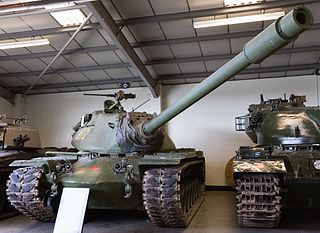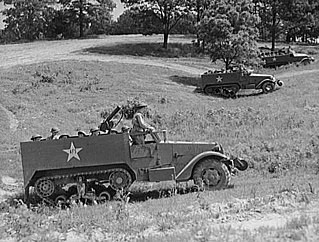
The M1 Abrams is a third-generation American main battle tank designed by Chrysler Defense and named for General Creighton Abrams. Conceived for modern armored ground warfare and now one of the heaviest tanks in service at nearly 68 short tons, it introduced several modern technologies to US armored forces, including a multifuel turbine engine, sophisticated Chobham composite armor, a computer fire control system, separate ammunition storage in a blowout compartment, and NBC protection for crew safety. Initial models of the M1 were armed with a 105 mm M68 gun, while later variants feature a license-produced Rheinmetall 120 mm L/44 designated M256.

The Leclerc is a third-generation French main battle tank developed and manufactured by Nexter Systems. It was named in honor of Marshal Philippe Leclerc de Hauteclocque, a commander of the Free French Forces, who led the 2nd Armoured Division in World War II.

The M60 is an American second-generation main battle tank (MBT). It was officially standardized as the Tank, Combat, Full Tracked: 105-mm Gun, M60 in March 1959. Although developed from the M48 Patton, the M60 tank series was never officially christened as a Patton tank. The US Army considered it a "product-improved descendant" of the Patton tank's design. The design similarities are evident comparing the original version of the M60 and the M48A2. It has been sometimes informally grouped as a member of the Patton tank family. The United States fully committed to the MBT doctrine in 1963, when the Marine Corps retired the last (M103) heavy tank battalion. The M60 tank series became America's primary main battle tank during the Cold War, reaching a production total of 15,000 M60s. Hull production ended in 1983, but 5,400 older models were converted to the M60A3 variant ending in 1990.

The Leopard 2 is a third generation German main battle tank (MBT). Developed by Krauss-Maffei in the 1970s, the tank entered service in 1979 and replaced the earlier Leopard 1 as the main battle tank of the West German army. Various iterations of the Leopard 2 continue to be operated by the armed forces of Germany, as well as 13 other European countries, and several non-European countries, including Canada, Chile, Indonesia, and Singapore. Some operating countries have licensed the Leopard 2 design for local production and domestic development.

The Type 90 tank is a main battle tank (MBT) of the Japan Ground Self-Defense Force (JGSDF). It was designed and built by Mitsubishi Heavy Industries as a replacement for the Type 61 and to supplement the then current fleet of Type 74 tanks, and entered service in 1990.

The Royal Ordnance L7, officially designated Gun, 105 mm, Tank, L7, is the basic model of the United Kingdom's most successful tank gun. It is a 105 mm L/52 rifled design by the Royal Ordnance Factories, intended for use in armoured fighting vehicles, replacing the older QF 20-pounder (84 mm) gun mounted on the British Centurion tank. The successful L7 gun has been fitted on many armoured vehicles, including the Centurion, the German Leopard 1 and, in an altered design, as the M68 gun in several variants of the US M48 Patton and M60.

The M103 Heavy Tank was a heavy tank that served in the United States Army and the United States Marine Corps during the Cold War. Introduced in 1957, it served through 1974, by which time evolution of the concept of a main battle tank considered heavy tanks obsolete.

The M10 tank destroyer was an American tank destroyer of World War II. After US entry into World War II and the formation of the Tank Destroyer Force, a suitable vehicle was needed to equip the new battalions. By November 1941, the Army requested a vehicle with a gun in a fully rotating turret after other interim models were criticized for being too poorly designed. The prototype of the M10 was conceived in early 1942 and delivered in April that year. After appropriate changes to the hull and turret were made, the modified version was selected for production in June 1942 as the 3-inch Gun Motor Carriage M10. It mounted a 3-inch gun M7 in a rotating turret on a modified M4 Sherman tank chassis. An alternate model, the M10A1, which used the M4A3 variant chassis, was also produced. Production of the two models ran from September 1942 to December 1943 and October 1942 to November 1943, respectively.

The M3 half-track was an American armored personnel carrier half-track widely used by the Allies during World War II and in the Cold War. Derived from the M2 half-track car, the M3 was extensively produced, with about 15,000 standard M3s and more than 38,000 variant units manufactured.

The M4 Sherman tank was produced in several variants, a result of mass production spread across several manufacturers and several years. It was also the basis for a number of related vehicles and Shermans have been modified by several nations, ranging from upgrades to complete hull conversions for another task. Originally designed in 1941, M4 variants were still used by Israel during the 1967 and 1973 wars with its Arab neighbors.

The General Dynamics Land Systems (GDLS) M60-2000 or 120S was an upgrade of the M60 tank. The development of the M60-2000 was initiated primarily due to the large number of M60 main battle tanks in service with many Middle Eastern nations unable to afford a sufficient force of more modern main battle tanks. The upgrade was marketed at those M60 users with the industrial capability to convert the tanks themselves. The M60-2000/120S was a GDLS supplied conversion kit that married the turret of the M1A1 variant of the M1 Abrams to the M60A1 hull of the M60, offering many features of the M1A1 Abrams to existing M60 users at a reduced cost.

The Battle of Phase Line Bullet was one of a series of engagements that led to the destruction of the Tawakalna Iraqi Republican Guard Division, on 26 February 1991, by a simultaneous attack of the 1st and 3rd armored divisions, the 1st Infantry Division, and the 2nd Armored Cavalry Regiment (2ACR) during the Gulf War.

The M901 ITV is an American armored vehicle introduced into service in 1979, and designed to carry a dual M220 TOW launcher. It is based on the ubiquitous M113 Armored Personnel Carrier chassis. The M901 ITV is no longer in service with the United States Army, its primary user.

The T92 Light Tank, or 76-mm Gun Tank, T92, was an American light tank developed in the 1950s by Aircraft Armaments. It was designed as an airborne/airdropped replacement for the heavier M41 Walker Bulldog while retaining the mobility, protection level, and firepower of the latter. The unveiling of the Soviet PT-76 amphibious light tank pointed out that the future US light tank should be able to swim as well. Making the T92 amphibious was deemed impractical and the light gun tank program was cancelled in June 1958.
The M1 Abrams main battle tank has been in service since 1980. Since then, it has gone through dozens of upgrades and been the baseline variant of several vehicles.

The M3 Bradley Cavalry Fighting Vehicle (CFV) is an American tracked armored reconnaissance vehicle manufactured by BAE Systems Platforms & Services. A member of the Bradley Fighting Vehicle family, the M3 CFV is used by heavy armored cavalry units in the United States Army.

The M2 Bradley, or Bradley IFV, is an American infantry fighting vehicle that is a member of the Bradley Fighting Vehicle family. It is manufactured by BAE Systems Land & Armaments, which was formerly United Defense.

This article deals with the tanks serving in the German Army throughout history, such as the World War I tanks of the Imperial German Army, the interwar and World War II tanks of the Nazi German Wehrmacht, the Cold War tanks of the West German and East German Armies, all the way to the present day tanks of the Bundeswehr.

The CM-11 Brave Tiger is a main battle tank (MBT) that was developed by the American General Dynamics and the Republic of China Army Armored Vehicle Development Center. It was introduced to the public on 14 April 1990. The CM-11 is a hybrid M60 chassis fitted with the turret from the older M48 Patton and the fire control system of the M1 Abrams.




















